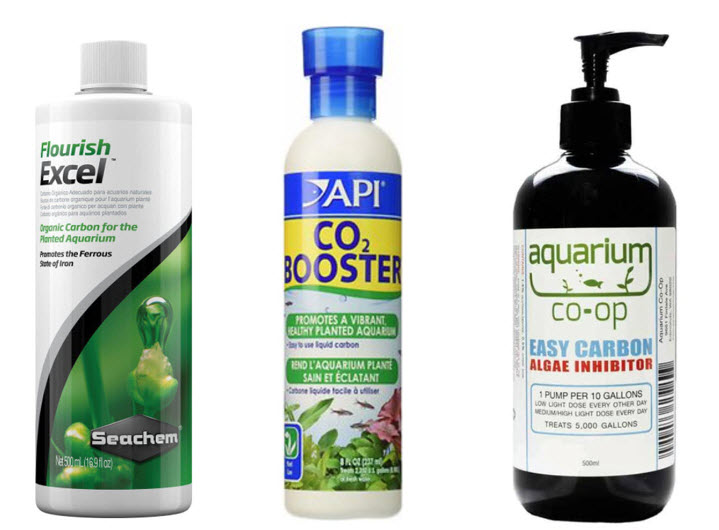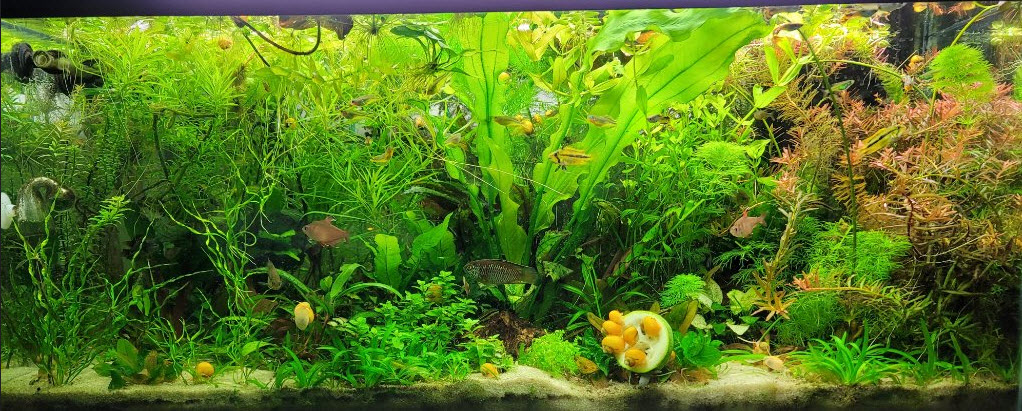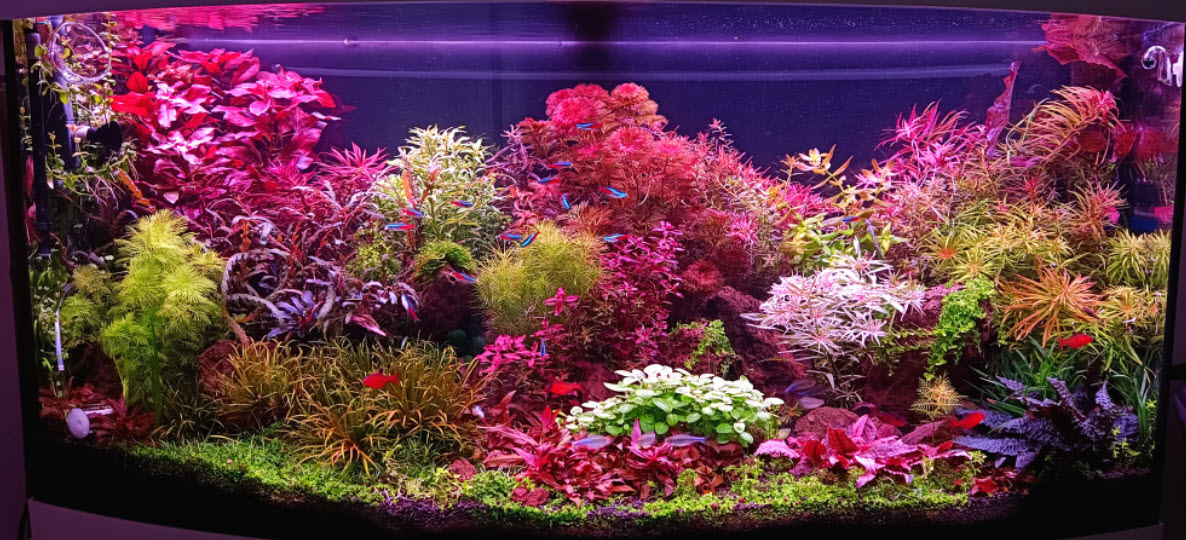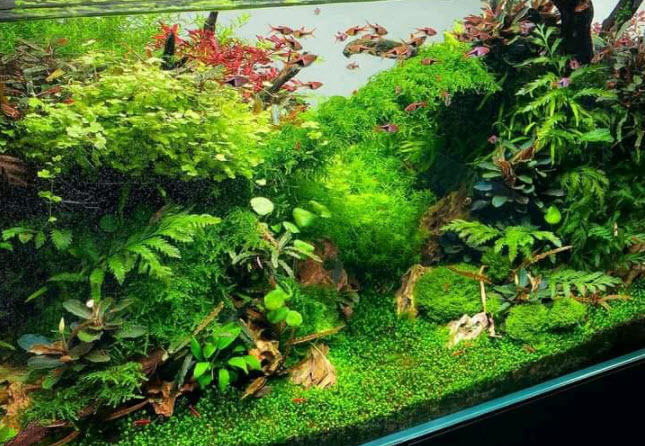
There are a whole series of products which supposedly add “liquid carbon” to a planted aquarium. There are three points which summarize the discussion:
- “Liquid carbon” does preferentially kill algae over vascular plants because the cell walls of algae are thinner than the cell walls of vascular plants.
- Since the cell walls of a fish’s gills are even thinner than that of algae, “liquid carbon” kills cells in the gills of a fish …. whoops
- “Liquid carbon” add only a TINY TINY bit of carbon dioxide to any aquarium
To go into more depth read on.
“Liquid Carbon” in Depth
There is one supplier which is honest about “liquid carbon”. It is Cory at Aquarium Co-op. Cory is the most knowledgeable and, more importantly, the ONLY honest expert in the business. What he says about “liquid carbon” is VERY instructive:
“What is Liquid Carbon?
Liquid carbon, also known as liquid carbon dioxide or liquid CO2, is offered by many aquarium companies as part of their plant fertilizer collection. You may see it sold in the United States under brand names like Seachem Flourish Excel, API CO2 Booster, and our own Aquarium Co-Op Easy Carbon. Almost all of these products contain glutaraldehyde or similar chemicals, which is known to reduce algae growth within a planted aquarium. When there is less algae competing for nutrients, light, and carbon dioxide, aquatic plants often grow faster and healthier as a result.
Does liquid CO2 replace pressurized CO2 gas? While liquid carbon is often marketed as a source of carbon, many planted tank experts agree that it is a poor replacement for CO2 gas. People set up high tech tanks to help their underwater plants by injecting more CO2 gas into the water at concentrations ranging from 10-30 ppm. Some initial studies have analyzed how much CO2 is released from recommended doses of liquid carbon, and the numbers were significantly lower than pressurized CO2. In fact, a normal aquarium with good surface agitation and gas exchange using an air stone or filter results in approximately 3-5 ppm CO2 in the water, which is still higher than what liquid carbon appears to supply.”
I cannot say it better than Cory says it. He is just right on. But others in the business are not so honest. Chief among these snake oil salesmen is Seachem.

“Liquid Carbon”
Any discussion of “liquid carbon” has to be predicated with a clarification.
.
“Liquid Carbon” is NOT liquid carbon.
.
“Liquid Carbon” products are an aldehyde, an organic compound that has carbon, hydrogen and oxygen atoms in its molecular structure. In theory, when the “liquid carbon” is metabolized by bacteria, it will produce very tiny amounts of carbon dioxide gas which plants can utilize. But the amount of carbon dioxide produced is negligible.

Flourish Excel™
Flourish Excel™ supposedly “adds carbon” to the planted aquarium. Seachem says of its product:
“Excel™ is an exclusive Seachem trade secret. It is based on many years of in house testing and research that shows a tremendous increase in growth similar in nature to that seen when CO2 is used. Polycycloglutaracetal is an isomeric form of glutaraldehyde… however it is less reactive and more easily utilized by plants as a carbon source. Once we have patented the product we would then be in a position to release detailed scientific studies (for trade secret reasons until then of course).“
To a chemist this is hilarious. This is just the “pseudo-scientific bedazzlement” so characteristic of Seachem with all its products. It is gibberish. All green plants and algae use carbon dioxide as their sole carbon source. There is no pathway by which an organic carbon compound can be utilized directly as a food source by green plants. If there were such a pathway sugar, organic acids (citric, acetic, etc.) or alcohol would provide the direct “carbon source” much more safely. Have you ever fertilized your garden with sugar?

Note that Seachem could easily release the results of their “detailed scientific studies” without revealing what their “Polycycloglutaracetal” is. But they don’t do that. Indeed, there isn’t a single study that can be found anywhere on Seachem’s website supporting any of its ridiculous marketing hype. Nor is there any study in the scientific literature supporting their claim.
Now there are a host of YouTube videos where everyone gets very “scientific” and uses a lot of big words to support the claims made by Seachem about Excel. Thing like the “Calvin cycle” etc. Take it from a genuine scientist, it is ALL just bull_____ . There are even some “side by side” comparisons where tanks had great plant growth with Excel and little plant growth without it. Understand, Seachem does a lot of “sponsoring” of YouTube makers. Don’t believe a word of it.

As a chemist let me assure you there is no such thing as “Polycycloglutaracetal”. It is possible for glutaraldehyde to do some polymerization but so what? Even low molecular weight polyglutaracetal would be insoluble in water and it would present as a white precipitate. Polymerized glutaraldehyde simply cannot be absorbed by plants and can do nothing to help the plants.
Excel™ is simply a solution of glutaraldehyde. Glutaraldehyde is a simple organic carbon containing compound C5H8O2. Like many simple organic compounds, it is decomposed into carbon dioxide by bacteria in the filter of the aquarium.

While glutaraldehyde does contain a minimal amount of carbon, using a standard dose, it releases very roughly 1 ppm of carbon dioxide via bacterial oxidation over twenty four hours. This would only release very roughly 0.04 ppm per hour. Atmospheric equilibrium from gaseous exchange provides roughly 1 ppm of carbon dioxide per hour at pretty much all times. So that means that doing absolutely nothing provides very roughly twenty five times more carbon dioxide than “liquid carbon”. So the “carbon” claim is a pure snake oil scam.
Note the excellent YouTube Channel Aquapros did a test of “liquid carbon” and found it simply did not work. It did not increase the growth of plants.

Wikipedia (sometime Wikipedia is correct!) gives an accurate assessment of glutaraldehyde:
“Glutaraldehyde, sold under the brandname Cidex and Glutaral among others, is a disinfectant, medication, preservative, and fixative. As a disinfectant, it is used to sterilize surgical instruments and other areas of hospitals. As a medication, it is used to treat warts on the bottom of the feet. Glutaraldehyde is applied as a liquid.
Side effects include skin irritation. If exposed to large amounts, nausea, headache, and shortness of breath may occur. Protective equipment is recommended when used, especially in high concentrations. Glutaraldehyde is effective against a range of microorganisms including spores.”
This data is confirmed by the OSHA write-up on glutaraldehyde. Does this sound like something you want to expose your fish or plants to?
Glutaraldehyde is closely related to formaldehyde but is eight times more toxic than formaldehyde. Glutaraldehyde is a disinfectant. Like all disinfectants it kills all living cells it meets: algae, plants, beneficial bacteria and the gills of the fish. So adding it to an aquarium is a balancing act of not killing enough cells to kill the plants or the fish while killing the algae. I will not use it in any form in my aquariums.

Further Information on CO2 Systems
General Information on CO2 in the aquarium can be found at this link:
15.6. CO2 in the Planted Aquarium
.
Return to Planted Aquarium Menu
.
Aquarium Science Website
The chapters shown below or on the right side in maroon lead to close to 400 articles on all aspects of keeping a freshwater aquarium. These articles have NO links to profit making sites and are thus unbiased in their recommendations, unlike all the for-profit sites you will find with Google. Bookmark and browse!
.
